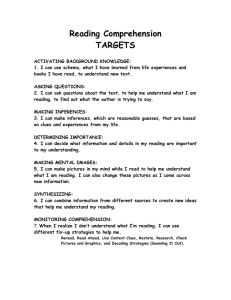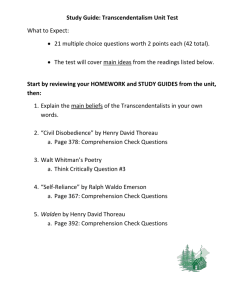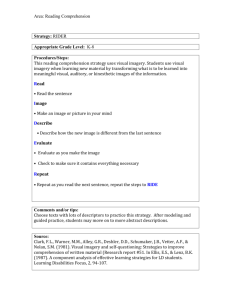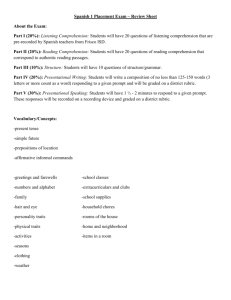Reading Next Presentation
advertisement
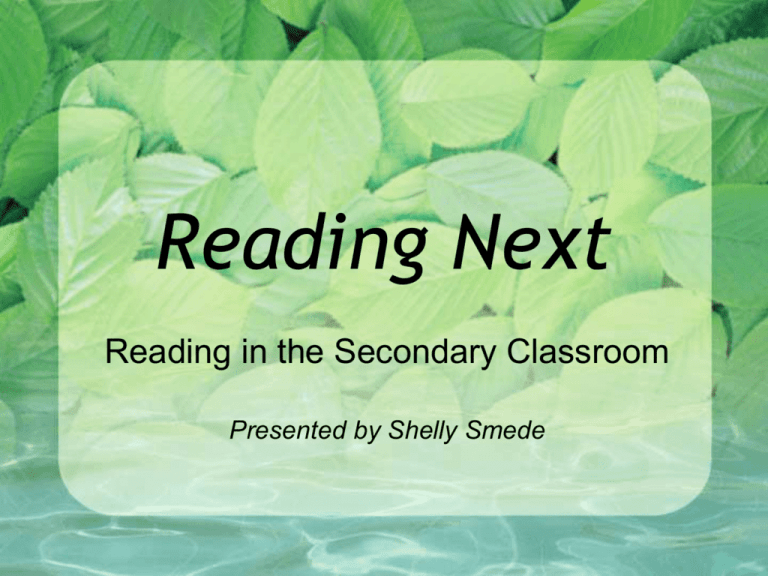
Reading Next Reading in the Secondary Classroom Presented by Shelly Smede Tips for Teachers Presenting to Other Teachers 1. 2. 3. If you are nervous, add some humor. These jokes will help ease the tension - even if you're the only one who thinks you’re funny. Use the phrase "new paradigm" as often as you can - it will add value to whatever you are presenting. Many teachers will sit in your session just long enough to get the handouts and then they will leave. Don't play into this little game. Always lock the door before you distribute any handouts. Tips for Teachers Presenting to Other Teachers 4. 5. Some cynic will always accuse you of being too much of an idealist and not enough of a realist. Tell this person that ideally, no one would say such a thing during someone else's presentation, but that realistically you figured someone would. Your level of expertise is in direct relation to the distance you are from your school. Tell those attending your session that you are from The Mid-Antarctic Consolidated School District. Five Fingers: I could teach this. Four Fingers: I know a lot about this. Three Fingers: I have heard of this. Two Fingers: This is new to me. 1. 2. 3. 4. Lexiles LiLI Reading Next Crayola Curriculum 5. 6. 7. New Idaho State Reading Standards Logographic Cues Graphic Organizers Findings in Reading • Teaching of formal reading instruction tends to end after elementary school. • 80% of elementary text is fiction. • 80% of secondary text is nonfiction. • Students must be trained in the literacy of each subject field. • About 70% of adolescents need some type of remediation. Findings in Reading • 50% of students read fewer than four minutes a day. • 30% read two minutes or fewer per day. • 10% do not spend any time reading. • 83% of faculty say that the lack of analytical reading skills contributes to students’ lack of success in a course. Findings in Reading • The current and future job market requires workers who are highly literate, which means they can read with comprehension, assess and interpret information, and utilize it appropriately. » The Principal’s Partnership Findings in Reading • “Based on 2005 ACT-tested high school graduates, it appears that only about half of our nation’s ACT-tested high school students are ready for college-level reading.” » ACT College Readiness Executive Summary Mike Schmoker Research Results Now, 2006 • In lowest achieving schools, most of the class period was spent on activities such as drawing or coloring or filling in worksheets that had no connection to learning outcomes. • Student work was handed in, but rarely returned. • In all schools, poor or affluent, students were rarely, if ever, reading. (86) The Crayola Curriculum • What was the single most predominant activity in the schools observed, right up through middle school? Coloring, Cutting, and Pasting Literature Based Arts & Crafts • Instead of reading and writing, students were found to spend most of their day making… • • • • • • • Dioramas Game boards Posters Mobiles Bookmarks Book jackets Coats of Arms… Reading Next Recommendations (Carnegie Foundation, 2004; NCTE, 2006) 1. Direct, explicit comprehension instruction 2. Effective instructional principles embedded in content 3. Motivation and self-directed learning Reading Next Recommendations (Carnegie Foundation, 2004; NCTE, 2006) 4. Text-based collaborative learning 5. Strategic tutoring 6. Diverse texts 7. Intensive writing Reading Next Recommendations (Carnegie Foundation, 2004; NCTE, 2006) 8. A technology component 9. Ongoing formative assessment of students 10.Extended time for literacy 11.Professional development Reading Next Recommendations (Carnegie Foundation, 2004; NCTE, 2006) 12.Ongoing summative assessment of students and programs 13.Teacher teams 14.Leadership 15.A comprehensive and coordinated literacy program Classes that spend their time (bell to bell) reading, writing, and talking result in… A College Prep Curriculum Reading Levels Independent Level of Reading: 95% word recognition; 90% comprehension without teacher assistance Instructional Level of Reading: 90% word recognition; 75% comprehension Frustration Level of Reading: Students recognize fewer than 90% of words and comprehend less than 50% At this level, students are too frustrated by the text to learn from it. (Beers, 2003, pg. 205) How long would you keep reading? Scientists use models to refer to a d____ or d____ of something, s____ one which can be used to make ____ that can be tested by ____ or ___. A h___ is a c___ that has been neither well supported nor yet ruled out by e___. A theory, in the context of science, is a l___ self-c___ model or f___ for d___ the b___ of certain n___ p___. A theory t___ d___ the b___ of much broader sets of p___ than a h___ — c___, a large number of h___ may be l___bound together by a single theory. A p___ law or law of nature is a s___ g___ based on a s___ large number of e___ o___ that it is taken as fully v___. Relationship between Time Spent Reading and Reading Achievement Fifth-Grade Students Minutes of Percentile Text Reading Rank per Day 98 90 70 50 20 10 90.7 40.4 21.7 12.9 3.1 1.6 from Anderson et al., 1988, Table 3, N = 155. Estimated Number of Words Read per Year 4,733,000 2,357,000 1,168,000 601,000 134,000 51,000 Reading Levels • “When students must read certain texts that you know will cause word recognition problems (frustration level of reading), then accept that you won’t be improving word recognition with that text.” » (Beers, 2003, pg. 242) State Standards – 10th Grade Standard 1: Reading Process Analyze the structure and format of various informational documents. Identify the text characteristics of different genres of literature. Apply knowledge of roots and word parts to draw inferences about new words. Use context analysis to determine the meanings of unfamiliar words. Standard 2: Comprehension/Interpretation Synthesize the content from several sources on a single issue; compare and contrast ideas to demonstrate comprehension. Apply reading strategies to self monitor for comprehension. Clarify an understanding of text by creating outlines, notes, annotations, charts, and/or diagrams. Critique the logic of informational texts by examining the sequence of information and procedures. Standard 2: Comprehension/Interpretation Define the purpose and audience of a variety of communication formats (e.g., essays, letters, user manuals, lab reports, websites). Evaluate the comprehensiveness and validity of evidence in an author’s argument. Read and respond to literature from a variety of genres. Analyze characters’ traits by what the characters say about themselves in narration, dialogue, and soliloquy. Standard 2: Comprehension/Interpretation Explain the author’s point of view and interpret how it influences the text. Compare works that express a universal theme and provide evidence to support the views expressed in each work. Analyze ways in which authors use imagery, figures of speech, and the “sound” of language for effect. Compare and contrast authors’ styles on the basis of such elements as word choice and sentence syntax. State Standards – 8th Grade Standard 2: Comprehension/Interpretation Determine the relationships among facts, ideas, and events used in various texts to support a central purpose. Distinguish cause and effect relationships in text to gain meaning. Make inferences, draw conclusions, and form opinions based on information gathered from text and cite evidence to support. Standard 2: Comprehension/Interpretation Evaluate expository text structure to extend comprehension. Generate how, why, and what-if questions for interpreting expository texts. Apply central ideas (literal of inferential) and critical details to summarize information from expository text. Identify the main purpose and anticipate outcomes of procedures specified in informational text. US Gov’t Instructional Calendar Skyline US Gov’t Instructional Calendar Skyline, cont. 69% of Idaho state reading objectives for tenth grade are those that should be utilized and learned across the curriculum. Inferences An inference is the ability to connect what is in the text with what is in the mind to make an educated guess. Read the following passage and discuss what you think is happening. “He put down $10 at the window. The woman behind the window gave $4.00. The person next to him gave him $3.00, but he gave it back to her. So, when they went inside, she bought him a large bag of popcorn.” » (Beers, 2003 pp. 62-63) Step Inside a Classroom • Teacher: What can you tell me about this passage? • S1: This doesn’t make any sense. • S2: It sort of does, down here, with the popcorn. Maybe it’s about a movie. • S3: It doesn’t say anything about a movie. • S1: I don’t get it. • S3: This is stupid. What’s Happening? • “These students don’t understand that reading requires action on their part…. They expect the text to provide everything. Their job, they believe, is at most to decode the print. After that, well, if the meaning isn’t immediately apparent, they stop reading or ask us to explain.” » (Beers, 2003, pg. 69) Before Reading Does purpose setting matter? – Pink: Memorize the following words. – Yellow: Count the vowels in the following words. – Blue: Rate each of the following words on its level of pleasantness, with 1 being “least pleasant” and 5 being “most pleasant. – If asked at the end of today’s workshop, only 50% of the memorizers would remember the words Activating Prior Knowledge “Laundry” “The procedure is really quite simple. First you arrange things into different groups depending on their makeup. Of course, one pile may be sufficient depending on how much there is to do. If you have to go somewhere else due to lack of facilities that is the next step; otherwise you’re pretty well set. It’s important not to overdo any particular endeavor. It is better to do too few things than to do too many….” » Bransford & Johnson (1972, JVLVB) Independent Readers… • Look at the… – Cover – Art – Title – Genre – Author – Headings – Graphs – Charts – Length – Print size – Front flaps – Back cover… Dependent Readers… • …are told to read something…and once the text is in their hands, they just begin. • They skip titles and background information. • They rarely look through the text for clues. • The assignment is to read, so they’ll read—maybe (Beers, 2003, pg. 74). Strategies 1. Anticipation Guides • • Present students with pertinent issues that are worth discussing but that don’t have clear-cut answers. Anticipation guides first act as a prereading strategy and encourage making predictions. They allow students to look for cause/effect relationships. They also allow students to generalize and explore their responses to texts. Anticipation Guide Before Reading After Reading 1. TV viewing is a major cause of health problems. Agree/Disagree? Agree/Disagree? 2. TV should supply pleasure rather than moralize. Agree/Disagree? Agree/Disagree? 3. Television is more beneficial than harmful. Agree/Disagree? Agree/Disagree? Probable Passage See Next Slide for Example • Brief summary based on key words from the text • Arrange words in categories • Write prediction statement that offers a gist of what the selection might be about. College Homework Anxiety-ridden Sardonic Obsessed Young Latinos Bellwether Wal-Mart Middle School Barbie Misgivings teens Nannies American Family PTA Meetings Prejudice Title: “Barbie to Baby Einstein: Get Over It” Characters: Setting: Problem: Gist Statement: Outcomes: Unknown Words: To discover: Tea Party • loathsome fire ants • metamorphosis takes place inside • eradicate • defend their nests • phorid fly implants one egg • won’t attack other species • 80% reduction • flies were released • inside the ant’s head During Reading Say Something! (Beers, 2003, pg. 106) – With a partner, decide who will say something first – When you say something, do one or more of the following • • • • • Make a prediction Ask a question Clarify a misunderstanding Make a comment Make a connection – If you can’t do one of these things, then you need to reread. Make a prediction • • • • I predict that… I bet that… I think that… Since this happened (fill in detail), then I bet the next thing to happen is… • Reading this part makes me think that this (fill in detail) is about to happen. • I wonder if… Ask a Question • Why did… • What’s this part about… • How is this (fill in detail) like this (fill in detail)… • What would happen if… • Why… • Who is… • Do you think that… Clarify Something • • • • • • Oh, I get it… Now I understand… This makes sense now… No, I think it means… I agree with you. This means… At first I thought (fill in detail), but now I think… • This part is really saying… Make a Comment • • • • • • • This is good because… This is hard because… This is confusing because… I like the part where… I don’t like this part because… My favorite part so far is… I think that… Make a Connection • This reminds me of… • This part is like… • This character (fill in name) is like (fill in name) because… • This is similar to… • The differences are… • This setting reminds me of… Say Something! (Beers, 2003, pg. 106) • If you can’t do one of these things, then you need to reread. Rereading • Prove to students that rereading is valuable • Model your thinking as you reread a text • Give students specific tasks as they reread • Review what happened as students reread. Logographic Cues ∆A - Change in Action ∆T - Change in Time ∆F - Change in Focus ∆S - Change in Setting ∆POV - Change in Point of View ∆D - Change in Direction ∆T/M - Change in Tone or Mood ∆C/S - Change in Condition or Status Jim Burke, Tools for Thought (6) Logographic Cues Protagonist Antagonist Confusing Setting Connection Idea Description Conflict Kylene Beers, (130) Two-Column Notes • Big Topic (Green) • Main Point Examples, Facts, Details • Main Point Examples, Facts, Details • Main Point Examples, Facts, Details Q Notes • Turn chap. titles & sub- • Answer questions here using bullets headings into questions and dashes to organize ideas: in this column: Chapter 11: “Focus on Literacy in Every Subject” Chapter 11 Subheadings • “Don’t Know Much About Biology” • “Project Pain” • “Adding and Subtracting Our Way to Literacy” • From Reading Doesn’t Matter Anymore by David Booth Reporter’s Notes (Burke, 2002) WHO (is involved or affected) Most important WHO WHAT (happened) Most important WHAT WHERE (did it or will it happen) Most important WHERE WHEN (did it or will it happen) Most important WHEN HOW (did they do it or did others respond) Most important HOW WHY (did they do this, react this way) SO WHAT? (why is this event/info/ idea important?) Most important WHY Most important SO WHAT? Spreadsheet Notes 1960’s Civil (Burke, 2002) Civil Rights Today Rights Movement ;djdjfld fdljfd ld dljd dlj dljd fd ldj dlfslj ld fdjfldjfl dsj ljdlfjldjf dllfdl ldsfld l. Individuals Involved ;djdjfld fdljfd ld dljd dlj dljd fd ldj dlfslj ld fdjfldjfl dsj ljdlfjldjf dllfdl ldsfld l. ;djdjfld fdljfd ld dljd dlj dljd fd ldj dlfslj ld fdjfldjfl dsj ljdlfjldjf dllfdl ldsfld l. Tone/Mood ;djdjfld fdljfd ld dljd dlj dljd fd ldj dlfslj ld fdjfldjfl dsj ljdlfjldjf dllfdl ldsfld l. ;djdjfld fdljfd ld dljd dlj dljd fd ldj dlfslj ld fdjfldjfl dsj ljdlfjldjf dllfdl ldsfld l. Historic Events ;djdjfld fdljfd ld dljd dlj dljd fd ldj dlfslj ld fdjfldjfl dsj ljdlfjldjf dllfdl ldsfld l. ;djdjfld fdljfd ld dljd dlj dljd fd ldj dlfslj ld fdjfldjfl dsj ljdlfjldjf dllfdl ldsfld l. Conflicts ;djdjfld fdljfd ld dljd dlj dljd fd ldj dlfslj ld fdjfldjfl dsj ljdlfjldjf dllfdl ldsfld l. ;djdjfld fdljfd ld dljd dlj dljd fd ldj dlfslj ld fdjfldjfl dsj ljdlfjldjf dllfdl ldsfld l. Outcomes ;djdjfld fdljfd ld dljd dlj dljd fd ldj dlfslj ld fdjfldjfl dsj ljdlfjldjf dllfdl ldsfld l. ;djdjfld fdljfd ld dljd dlj dljd fd ldj dlfslj ld fdjfldjfl dsj ljdlfjldjf dllfdl ldsfld l. Significance ;djdjfld fdljfd ld dljd dlj dljd fd ldj dlfslj ld fdjfldjfl dsj ljdlfjldjf dllfdl ldsfld l. Target Notes EVIDENCE EVIDENCE Kino The Trackers EVIDENCE Coyotito The Pearl The Pearl Buyer Jauna The Doctor EVIDENCE EVIDENCE EVIDENCE After Reading Somebody Wanted But So (character) (motivation) (conflict) (resolution) Rachel To feel 11 on her She is birthday humiliated when her teacher forces an old sweater on her. Rachel’s Teacher to return the sweater to its rightful owner she doesn’t know who owns it She feels helpless as she bursts into tears at her desk. she mistakenly makes Rachel take it and even put it on. Question 1. Read the Question. It Says 2. Find information from the text that will help you answer the question. I Say 3. Think about what you know about that information. And So 4. Combine what the text says with what you know to come up with the answer. Question It Says 1. Why doesn’t Rachel just tell her teacher the sweater isn’t hers? 2. In the story, she says that when she opens her mouth to say the sweater isn’t hers, that nothing comes out. I Say 3. Sometimes when I am really surprised or unhappy, I can’t think of anything to say to help change the situation. This is an easy formula for making inferences! And So 4. I think that Rachel wasn’t prepared to have her teacher treat her like this on her birthday. So when it does, she doesn’t have the words to protest. Conversational Roundtable (Burke, 2002) Teenage Girls Teenage Boys Cliques Teachers Parents Think in Threes Ancient Rome (Burke, 2002) Ancient China Gov’t Early America Think in Threes 1984 (Burke, 2002) Catcher in the Rye Rebellion & Conformity Kite Runner Think in Threes Nervous System (Burke, 2002) Respiratory System The Brain Circulatory System Teaching Vocabulary A Six-Step Process for Teaching Vocabulary • Step 1: Provide a description, explanation, or example of the new term. • Step 2: Ask students to restate the description, explanation, or example in their own words. • Step 3: Ask students to construct a picture, symbol, or graphic representing the term or phrase. • Step 4: Engage students periodically in activities that help them add to their knowledge of the terms in their notebooks. • Step 5: Periodically ask students to discuss the terms with one another. • Step 6: Involve students periodically in games that allow them to play with terms. Student Vocab Organizer (Marzano, Building Background Knowledge) Term: My Understanding 1 2 3 4 Category:___________________________________________ Describe: ___________________________________________________ ___________________________________________________ ___________________________________________________ ___________________________________________________ Draw: Academic Vocabulary Give Students the Smart Words Words to Describe the Plot Positive Negative Realistic Good pacing Suspenseful Satisfying ending Subplots connected well Well-developed ideas unrealistic plodding Predictable Frustrating ending Confusing subplots Sketchy ideas Give Students the Smart Words Words to Describe Characters Positive Negative Original Believable Well-rounded Multi-dimensional Well-developed Stereotyped Unbelievable Flat Static/stays same Flawed Give Students the Smart Words Words to Describe the Theme Positive Negative Important Message Subtle Unique Powerful Memorable Unimportant message Overbearing Overworked Ineffective Forgettable Give Students the Smart Words Words to Describe Author’s Style Positive Negative Descriptive/use of metaphors Original Lively, full of action Poetic or lyrical Boring, no imagery Filled with clichés Slow-moving Clodding, jumpy “Becoming a reader shapes who we are, how we see the world, and how we see ourselves in the world. Tragically, failure to become a reader shapes our perceptions as well.” Kylene Beers, 2003
